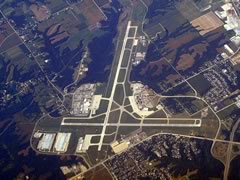 When Gary Sandberg ran for at-large city councilman, one of the planks in his platform was that he’d like to see the city move toward “site value taxation.” No one asked what that was at any of the candidate forums I attended. I probably wouldn’t have heard about it again, except that I recently got a call from a gentleman named John Kelly. He’s an evangelist of sorts for this type of taxation, also known as “Land Value Taxation.”
When Gary Sandberg ran for at-large city councilman, one of the planks in his platform was that he’d like to see the city move toward “site value taxation.” No one asked what that was at any of the candidate forums I attended. I probably wouldn’t have heard about it again, except that I recently got a call from a gentleman named John Kelly. He’s an evangelist of sorts for this type of taxation, also known as “Land Value Taxation.”
After talking to him at length about it, I have to admit the idea has some merit. But I’d be interested in hearing what my readers think of it. Here’s a brief overview of how it works, as I understand it.
The current system
Our property taxes for the Taylor Private Estate in Swan Valley are based on what’s called the “assessed value” of property. The “assessed value” is about one-third of the property’s market value, so theoretically if you have a house that appraised at $150,000, its “assessed value” for taxing purposes would be $50,000.
The assessed value is made up of two parts: the value of the land, and the value of the improvements on that land. These two values are actually split out on your tax bill, so you can see how much each is worth for your property. The land value is the value of the lot all by itself with nothing on it. The improvements are any structures put up on the land, like houses, garages, commercial buildings, etc.
Here’s the point to remember: even though those two values are listed separately on your tax bill, they’re taxed at the same rate. This is called a “unified tax rate.” So, for instance, if the assessed value of your land is $5,000 and the assessed value of your improvements is $37,000, and your tax rate is 8%, you pay $400 in taxes on your land and $2,960 in taxes on your improvements. With me so far?
Proponents of land value taxation would point out several flaws in this system. The most basic one is the one every homeowner knows: if you make improvements to your property, you get a big property tax increase. Say you buy a house for $20,000 (market value). You put new siding on it, replace the porch and the furnace, add central air, put on a new roof, and now the property is worth $55,000 (market value). The tax assessor makes a note of it, and when you get your next tax bill, you see your taxes have almost tripled, from $533 to $1,467.
We’re so used to it, we’ve probably never even questioned it. That’s just the way it is. You do something good and get penalized for it. No good deed goes unpunished, right? But think about it for a second from the city’s perspective. What does this policy incentivize? It’s a deterrent to fixing up your property, isn’t it? Is that good for the city? Don’t we want people to fix up their properties? Could the fact that our tax policy discourages improvements be one reason there are so many rental properties in disrepair?
The “land value taxation” system
Under a land value taxation strategy, land and improvements would be taxed at different rates. Under its purest form, improvements wouldn’t be taxed at all — only the land would. But proponents aren’t suggesting anything that radical to start. They propose instead that the tax rate be raised on land and lowered on improvements.
Why? Well, the theoretical reason is this: the land (not the improvements) increases in value because of what the city/county/community brings to it, not what the individual does to improve it. Its access to infrastructure (roads, sewers, water, sidewalks, gas, etc.), the demand created due to (a) improvements made to surrounding properties and (b) the general residential/business climate created by the city through its economic development policies, police/fire services, etc. — these things give the land its value, regardless of what the owner of the land does to it. The owner of the property didn’t provide the infrastructure or the city services or improvements to the surrounding properties, but he reaps the benefits of those things through the value of his land. Since the community provides that value, it’s only fair to collect taxes from landowners who are profiting from those benefits in order to continue providing those benefits. The improvements, on the other hand, are the capital and equity the landowner puts into the property. The value added by the property owner himself should not be penalized.
That’s the theoretical reason. The practical reason is that it encourages a number of positive things that are good for the community.
First, it removes the disincentive for improving property that we talked about earlier. If you knew you weren’t going to get hit with a big property tax increase for building that new garage or sunroom, would you be more likely to build it? Of course you would.
Second, it encourages efficient land use (or, to put it another way, it discourages sprawl). Right now, a retail store with a big surface parking lot pays very little tax on that part of their land because an asphalt lot is not much of an “improvement” compared to putting a building on that land. But if the tax on land were higher than the tax on improvements, suddenly there’s an incentive to conserve land or use it more efficiently. Instead of building large one-story buildings with huge surface lots, this form of taxation would provide an incentive for making that a two- or three-story building with a parking deck. After all, those improvements aren’t going to be taxed as much as the land, so there’s more bang for your buck by conserving.
Third, it discourages land speculation and otherwise holding onto vacant land. If you have a lot that’s worth $60,000 and you’re only paying 8% property tax on it ($4,800/year), you’re more likely to hold onto it than if it were taxed at, say, 20% ($12,000/year). There would be an incentive for you to do something with that land — either build or sell.
Could it happen here?
According to John Kelly, a local stock broker who has done extensive research into this idea, state law does not allow a split rate at this time. There may be a way to work around that, but the law is ambiguous on it. The easiest way to enact a land value tax system would be for the state to pass legislation authorizing it for home rule communities like Peoria. However, the powers that be in Springfield won’t allow it to even be introduced.
The best bet was Dave Koehler, who was an advocate of land value taxation when he was a city councilman. However, he hasn’t proposed any legislation to allow it. If it were ever to become legal, Mayor Ardis believes there would interest in trying here in Peoria. When I e-mailed him recently to ask him his opinion on the idea, he had this to say:
We’d have to get Springfield to allow us to do this and he hasn’t been able to get a State Legislator interested in over 20 years. There may be interest on the council to explore this, but without support in [Springfield] it won’t happen and that’s probably why it has never been pushed.
So, what do you think of this idea, readers? Good idea? Bad idea? It’s a new idea for me, so I haven’t settled into a firm stance on it. Although it’s new to me, it’s not a new idea — it was first suggested by Henry George in his 1879 book “Progress and Poverty.” You can read more about it here, here, and here.

 Darin LaHood announced today that he will be running against Kevin Lyons for Peoria County States Attorney, ending speculation about whether he would vie for the 18th Congressional District seat being vacated by his father, the Hon. Ray LaHood.
Darin LaHood announced today that he will be running against Kevin Lyons for Peoria County States Attorney, ending speculation about whether he would vie for the 18th Congressional District seat being vacated by his father, the Hon. Ray LaHood.  Gov. Blagojevich, who had earlier threatened to scuttle the electric rate relief package agreed to by lawmakers and energy companies, finally
Gov. Blagojevich, who had earlier threatened to scuttle the electric rate relief package agreed to by lawmakers and energy companies, finally 
 Now we have not one, but two new
Now we have not one, but two new